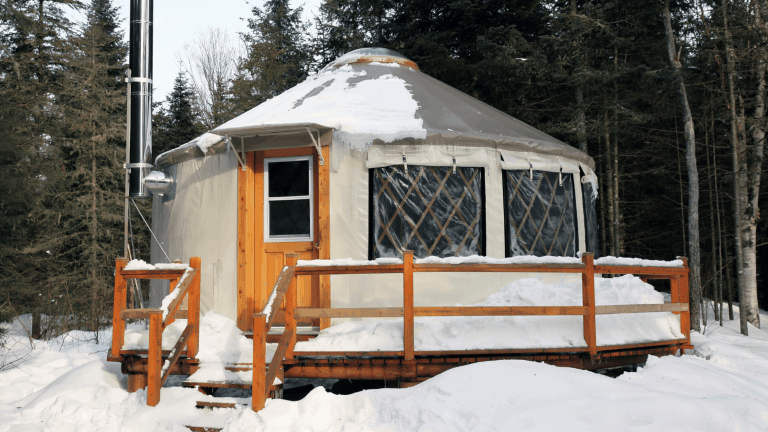Yurt Moisture: How to Keep Your Yurt Dry and Cozy
I’ve always loved the idea of living in a yurt. I think they are beautiful, environmentally friendly, and they just seem like great places to live. There is one problem, though; it can get really wet inside during certain times of the year with all the rain we’re getting in my neck of the woods. But there are some things you can do to make sure your home stays dry and cozy.
Are yurts humid? Why does it get wet inside during the rainy season?
Yurts are made of wooden lattice walls with a circular roof held up by wooden rafters. The yurt is covered in a waterproof, strong fabric cover made out of canvas or synthetic waterproof materials to keep the elements from seeping in when it rains.
Cotton canvas is a fantastic and durable material, but it becomes waterproof as a result of the way it expands after absorbing water. During heavy rains, this can cause the inside of your walls and ceiling to be damp, causing your yurt to feel like a sauna in the summertime and makes you feel cold and uncomfortable during winter.
But also yurts made from other fabrics can get damp inside, and some of the less-breathable materials are not as good at allowing humid air out. This may cause mold to form within your yurt, which is bad for your health and lowers the longevity of your yurt.
That being said, there are some easy things you can do to decrease indoor humidity during wet weather. In this article, we’ll discuss the best ways to keep your yurt dry and cozy during the wet seasons.
How to keep your yurt dry and cozy – tips for keeping your yurt from being too damp
The most important thing you can do to keep your yurt dry is to ventilate it. Ventilation is essential to the health of your yurt and its occupants. The air inside a yurt can get full of moisture from cooking, showering, or just daily living. This creates humidity that can cause the walls to feel damp during heavy rains.
But with good ventilation, this humidity will be removed from your home before it has time to build up. Make sure to open the dome window at the top of your yurt to allow moist air out, and open windows or use a fan where you spend most of your time inside. If you tend to forget to open the dome, you can install an automated system to open the windows when the humidity gets too high.
An open dome will go a long way in reducing the humidity inside your yurt. Although, For efficient ventilation, you will need to open a number of windows or have an air vent installed.
You could also buy a dehumidifier. This is particularly helpful if your yurt tends to get damp inside after heavy rains, but it can be used all year-round. Dehumidifiers remove humidity from the air and will prevent mold, mildew, and rot on surfaces within your yurt.
If you notice that there is too much moisture in your yurt (condensation on windows, water on the flooring, or your furniture feels moist), make sure you ventilate the space more until it clears up. A dehumidifier will also help to remove humidity from the air if there is too much moisture in your yurt, but make sure it’s also vented out through an open window or door.
Heating and ventilation go hand-in-hand during the winter. Hot air rises to the top of your yurt, and it can contain more water vapor. When you open the dome at the top of your yurt, this humid air will be released, and it can make a big difference in how damp your walls and furniture are. Just remember to close your dome and windows again to not waste energy.

Insulate Your Yurt
Insulation can help to keep your yurt warm and dry. It’s a good idea to have insulation in your walls because it keeps the heat from seeping out of your home, maintaining a comfortable temperature inside. An insulated wall will also reduce condensation on the interior of your yurt during cold or rainy days.
It’s also important to make sure you have insulation in your roof. Your yurt can get pretty cold during the winter, so adding this extra layer of insulation will improve the quality of your interior walls and ceilings by keeping them warmer.
Some natural materials are better at insulating than others, with wool being one of the best. However, many people choose foam over wool for insulation because it is even more efficient. Cotton is also popular but subject to molding.
A good way to keep the floor of your yurt dry and cozy during these winter months is by installing proper floor insulation. This will help your home stay warmer and protect it against humidity from the ground. An effective and affordable way to keep your yurt dry and cozy is with a wood pier-style foundation. This will keep the yurt from damage caused by rain and humidity while also lowering the risk of mice infestations.
If there is no heating system in the yurt, different forms of insulation become even more important. Not only will having insulation maintain a comfortable temperature inside, but it may also save on heating costs because less heat will escape from your yurt into the surrounding environment.
For more in-depth info on how to insulate your yurt, read my other article, “Yurt Insulation: Staying Warm In a Yurt.”
How Do You Stop Mold in a Yurt?
Mold can be a big yurt moisture issue. Mold spores can be quite harmful to humans and animals, so a high level of humidity in your home is a real health risk. To prevent this from happening, you need to reduce excess humidity levels, as mold spores thrive in moist environments. Keeping humidity levels in the 30% to 50% range will help to prevent mold in your yurt.
Besides proper ventilation, heat, and insulation, you should also consider adding reflective foil in your wall and roof insulation that reflects heat back into the interior space and functions as a vapor barrier. This is particularly recommended if your yurt is made from cotton canvas or other organic materials.
If you find mold and mildew in your yurt, you’ll want to get rid of it right away before it spreads or does permanent damage. Make sure to wear a mask while cleaning out mold in order to prevent breathing problems, and go outside when cleaning moldy furniture, clothes, etc., so you don’t spread mold spores throughout your space.
Bleach is the most effective way to kill mold, so use a diluted bleach solution to clean up the moisture and mold. Rinse with distilled water afterward.
In Summary
If you live in a yurt, then the chances are that it gets humid from time to time. If this is the case, there may be mold growing inside your home. To keep your yurt from being too damp and prevent any unwanted growths of fungus or bacteria, consider insulating your walls with natural or foam insulation before winter sets in.
You should also make sure that there’s a lot of ventilation by opening up the dome and windows as often as possible during the daytime hours when temperatures outside allow for it. Lastly, any beginning mold or mildew should be cleaned out before it spreads.


![Can You Live In A Yurt Year-Round? [4 Things To Consider!]](https://freedomresidence.com/wp-content/uploads/2022/05/Can-You-Live-in-a-Yurt-Year-Round-1-768x512.jpg)

![Do Yurts Have Running Water? [6 Steps To Success!]](https://freedomresidence.com/wp-content/uploads/2022/05/Do-Yurts-Have-Running-Water-768x512.jpg)
